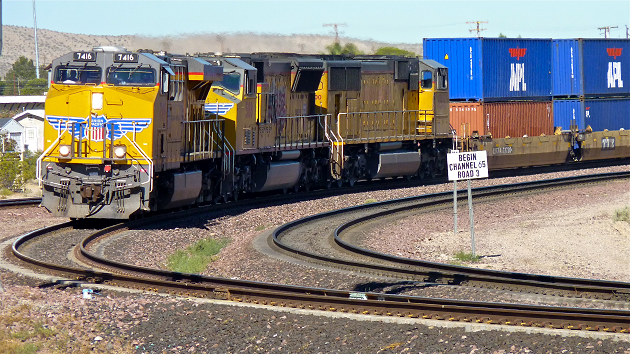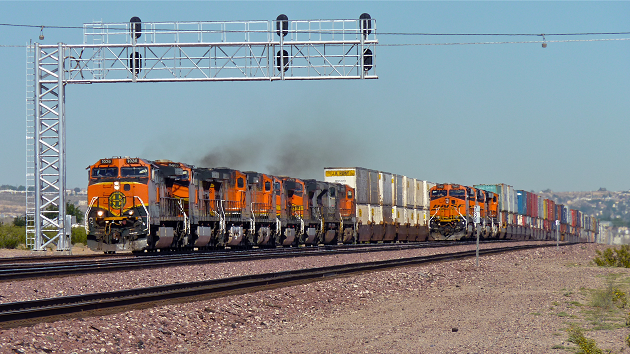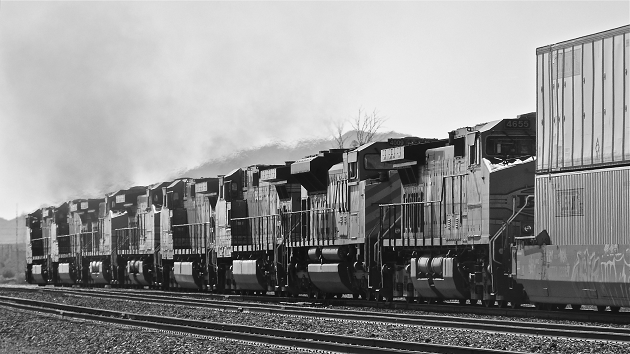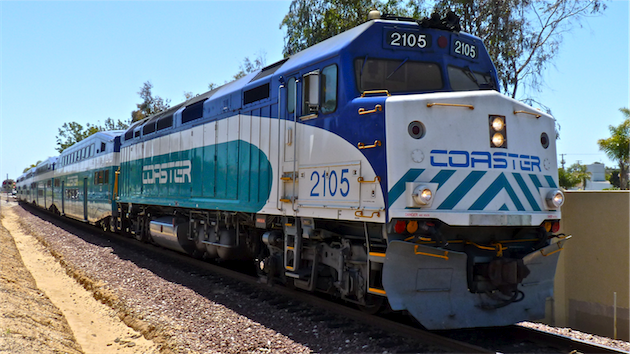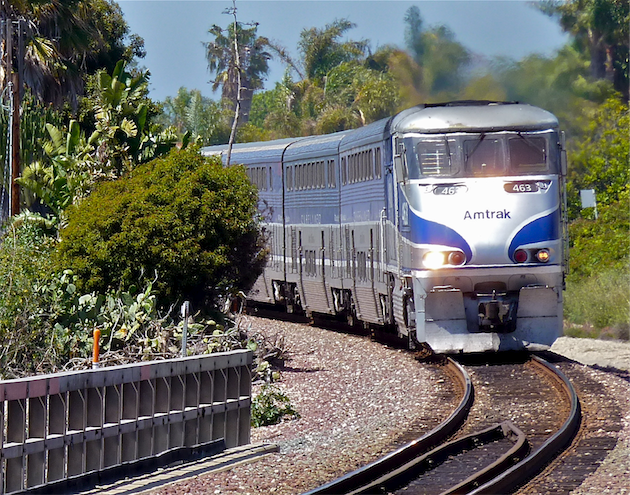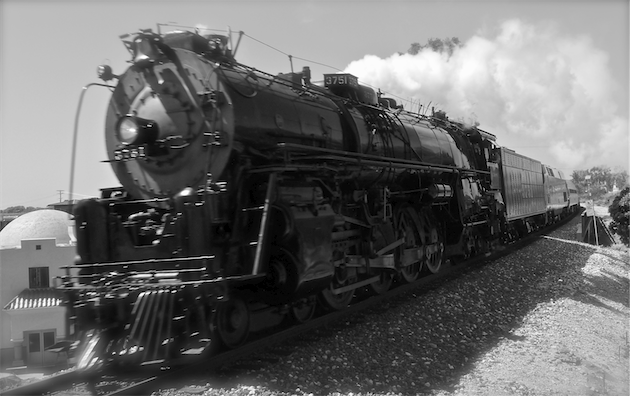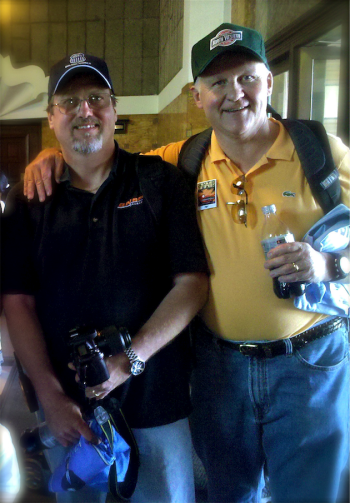The Memorial Day Weekend Mega Tour - Part 2
(Continued from: The Memorial Day Weekend Mega Tour - Part 1)
With the high traffic level I encountered at Daggett in short order, I drove north on the Daggett-Yermo Road towards Yermo hoping that the Cima Subdivision provided ample traffic and photo opportunities. I had already seen two eastbound Union Pacific trains return to home rails and head off towards Yermo and I was in pursuit.
I had planned to follow the tracks via Yermo Road which roughly parallels the Cima Subdivision for the first sixteen miles north out of Yermo. I reached one of the few grade crossings on Yermo Road that I used to get on the sunlit side of tracks and wait for a train out of, or inbound to, Yermo. I set-up at Minneola Road at caught this eastbound intermodal after a short wait:
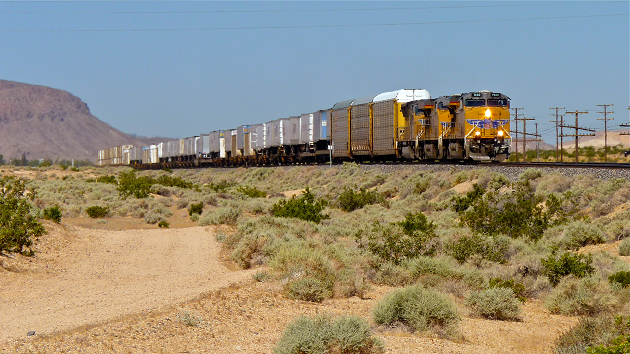 UP 7660 East at Minneola Road - UP 7660 (GE C45ACCTE), UP 7371 (GE C45ACCTE), and UP 4984 (EMD SD70M) are on the move again after a brief stop at Yermo, CA with this eastbound intermodal consist, seen here at Minneola Road. [5/29/2010 - Cima Subdivision]
UP 7660 East at Minneola Road - UP 7660 (GE C45ACCTE), UP 7371 (GE C45ACCTE), and UP 4984 (EMD SD70M) are on the move again after a brief stop at Yermo, CA with this eastbound intermodal consist, seen here at Minneola Road. [5/29/2010 - Cima Subdivision]
By listening to the railroad’s radio traffic I gleaned that there was a westbound a dozen miles or so east of Minneola Road so I continued east. As I closed the distance and continued to listen to the railroad’s road channel, the picture became clear that the westbound train “in the hole” waiting to meet the eastbound that I had just photographed. Since the Cima Subdivision is single tracked, trains need to pass or meet other trains at locations designed for this purpose, called sidings.
I didn’t make it in time to see the meet. The crew of the westbound performed a “roll-by” inspection of the eastbound train as it passed the siding. The crew identified, and subsequently informed the other train via radio, that one of the containers the train was carrying appeared to be have been broken into.
It turns out that this is a big problem for the railroads, particularly in the more remote locations of the desert. This served to remind be to keep an eye open for riders and, more importantly, be careful of other folks that I might encounter track side because these criminals have been known to carry guns as well.
I did manage to capture the westbound as she meet me at the detector located at milepost 175.3:
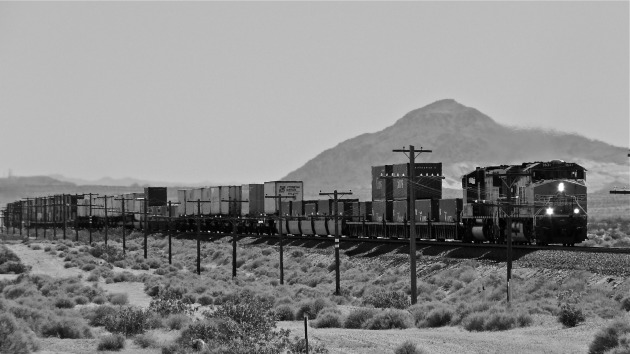 UP 7631 West - UP 7631 (GE C45ACCTE) and UP 3991 (EMD SD70M) approach the hotbox detector at MP 175.3, near Manix, CA, with a westbound intermodal train. [5/29/2010 - Cima Subdivision]
UP 7631 West - UP 7631 (GE C45ACCTE) and UP 3991 (EMD SD70M) approach the hotbox detector at MP 175.3, near Manix, CA, with a westbound intermodal train. [5/29/2010 - Cima Subdivision]
As the westbound hustled towards Yermo, I continued east on Yermo Road to another grade crossing opportunity at Alvord Mountain Road. Once I got to the intersection I saw the road blocks on Yermo Road preventing further use of Yermo Road east of the intersection for some reason. It became apparent that I would not be able to run along the tracks any further from Yermo Road so I decided to take a break on the south side of the tracks on Alvord Mountain Road.
I parked the truck in the shade of a small tree adjacent to the grade crossing and rested a bit in hopes of catching another passing train while I was on the “sunny side” of the tracks. After about a fifteen to twenty minute wait, with no radio chatter from detectors or crews, I decided to keep moving east.
I pulled the truck up to the grade crossing and slowed to get one last look at the signals for an indication that something was “lined” my way when I saw a white vehicle kicking up a serious dust cloud on the railroad access road headed towards me.
Not wanting to sit on the crossing, but still curious as to who or what the white vehicle quickly approaching was, I parked on Yermo Road. I thought perhaps it might be a signal maintainer or other MOW crew.
The vehicle finally got to the grade crossing an although it remained on the south side of the tracks, it stopped near where I parked. I couldn’t quite make out the details of the sign that adorned the vehicle’s door but I could tell that it was either a Union Pacific Railroad Police officer or a “contract security firm” hired out by the Union Pacific. Either way I garnered a long and curious stare from the single occupant of the vehicle.
I assumed that he might not be able to see who I was clearly so I decided to exit my vehicle and stand there in case he wanted to approach me and ascertain my intent for being in the area. Maybe this was sufficient enough for him to conclude that I was harmless because he promptly continued east on the access road after I exited my vehicle. Perhaps he thought I might have been connected with the break- in of that eastbound intermodal train - who knows.
Since I was forced to take Interstate 15 north to continue my trip I thought I would exit at the next opportunity and double back south down Yermo Road to continue my track side chase. The exit that I choose was Field Road. Here I made an immediate right turn onto Yermo Road and discovered two California Highway Patrol vehicle parked with the officers chatting and a permanent “Road Closed” sign and blockade behind them. Bummer, it was obvious that I would not be able to access that region of the Cima Subdivision without trespassing or using the railroad’s service road - something I was not willing to do. I got back on Interstate 15 and continued northeast.
I did plan to bypass the most picturesque region of the Cima Sub, Afton Canyon, which lay a few miles north of the Field Road exit because I was a solo vehicle weighing nearly 11,000 pounds. I did not want to bury the truck in the sand and not have a buddy close by to pull me out so I continued on to Baker, California.
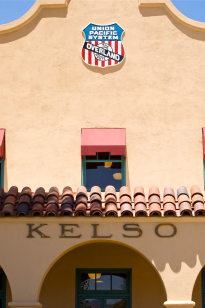
After a pit stop in Baker for food and fuel, I turned onto Kelbaker Road which would take me into the heart of the Mojave National Preserve and facilitate my return to the tracks of the Cima Sub.
After about a 45-minute drive I arrived at Kelso, California and the beautifully-restored, former Union Pacific passenger depot which is now a Visitor’s Center for the National Park Service. I pulled into the parking lot, gathered my materials, and made a beeline for the depot to get some relief from the heat and talk to a ranger about my plans. It was a good thing I did.
Using the park map which was on top of the Information Desk counter, I outlined my plan for one of the rangers there. He promptly advised me that my planned route would take my onto Union Pacific’s private property because the shown road on the map was actually a railroad access road and not a Park Service road. He did advise me that I could take a parallel route over Powerline Road but it was one to two miles away from the tracks - certainly not ideal. “Bummer,” I thought.
I then asked about camping along Powerline Road and he proceeded to recite the Park rules and regulations governing camping inside the Park. Basically “roadside camping,” as he referred to it, is only allowed at selected preexisting sites and none of them where were I had hoped they would be in relation to the tracks. “Bummer,” I thought, once again.
At this point, I suspect due to a sense of pity on me, the ranger divulged the location of a little-known campsite near Cima that he thought might best suit me and my desires. We chatted about accessibility due to my truck’s size and weight. He asked if I had 4-wheel drive to which I said “yes.” I then explained about the 11,000 pounds of my truck’s weight and the difficulty that presents in sand. He said “it shouldn’t be too bad.” “Great,” I thought to myself, “what’s that mean?”
I turned for the door as I thanked him for his time and insight and especially the suggestion of the “secret” campsite. “Oh, one more thing” he added. “The rattlesnakes are out in abundance.” “Great,” I thought to myself. I knew what that meant…
 BNSF,
BNSF,  Cima Subdivision,
Cima Subdivision,  Mega Tour,
Mega Tour,  Railfan,
Railfan,  Railfanning Trip,
Railfanning Trip,  Union Pacific Railroad CATEGORIES:
Union Pacific Railroad CATEGORIES:  General Photography,
General Photography,  Railroad Photography
Railroad Photography 
